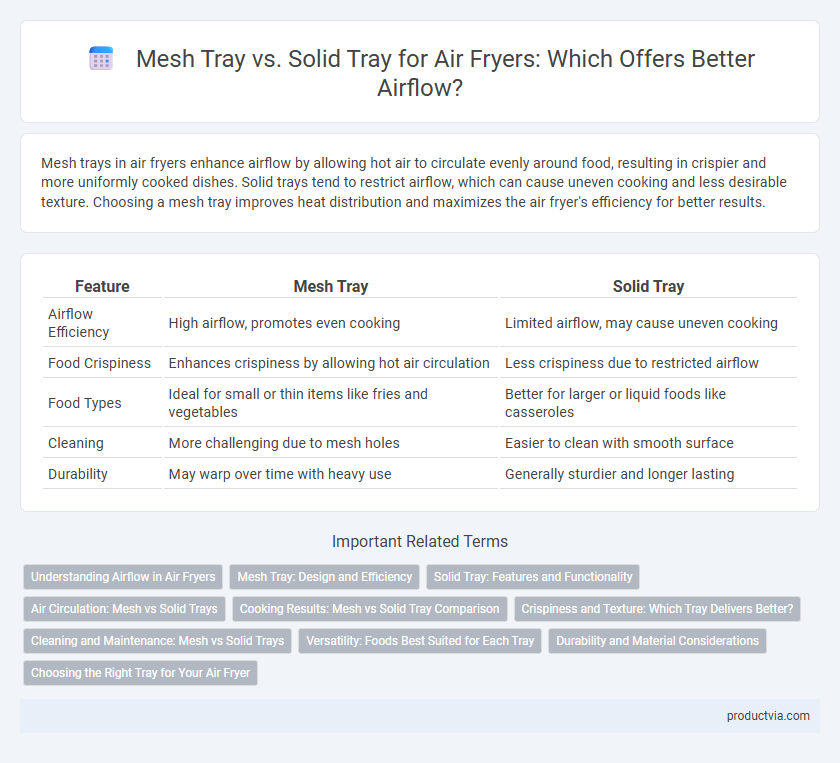Mesh trays in air fryers enhance airflow by allowing hot air to circulate evenly around food, resulting in crispier and more uniformly cooked dishes. Solid trays tend to restrict airflow, which can cause uneven cooking and less desirable texture. Choosing a mesh tray improves heat distribution and maximizes the air fryer's efficiency for better results.
Table of Comparison
| Feature | Mesh Tray | Solid Tray |
|---|---|---|
| Airflow Efficiency | High airflow, promotes even cooking | Limited airflow, may cause uneven cooking |
| Food Crispiness | Enhances crispiness by allowing hot air circulation | Less crispiness due to restricted airflow |
| Food Types | Ideal for small or thin items like fries and vegetables | Better for larger or liquid foods like casseroles |
| Cleaning | More challenging due to mesh holes | Easier to clean with smooth surface |
| Durability | May warp over time with heavy use | Generally sturdier and longer lasting |
Understanding Airflow in Air Fryers
Mesh trays enhance airflow in air fryers by allowing hot air to circulate more freely around food, resulting in even cooking and crispier textures. Solid trays tend to restrict airflow, causing potential uneven heating and longer cooking times. Optimizing tray type based on airflow dynamics significantly improves air fryer performance and food quality.
Mesh Tray: Design and Efficiency
Mesh trays in air fryers feature a perforated design that promotes superior airflow, allowing hot air to circulate evenly around the food for crispier results. This enhanced ventilation reduces cooking time and ensures consistent heat distribution, optimizing energy efficiency. The open structure also prevents moisture buildup, making mesh trays ideal for frying vegetables, fries, and other items that benefit from a dry, crispy texture.
Solid Tray: Features and Functionality
Solid trays in an air fryer offer a flat, non-perforated surface that retains juices and sauces, making them ideal for cooking dishes like casseroles or baked goods that require even heat distribution without dripping. Their design ensures consistent temperature control and prevents smaller food items from falling through the gaps, enhancing versatility for diverse cooking needs. Solid trays also facilitate easy cleanup by containing grease and food particles, making them a practical choice for recipes needing more liquid retention.
Air Circulation: Mesh vs Solid Trays
Mesh trays in air fryers enhance air circulation by allowing hot air to flow freely around food, resulting in faster cooking and crispier textures. Solid trays restrict airflow beneath the food, potentially causing uneven cooking and longer cooking times. Optimal air circulation in mesh trays promotes even heat distribution, maximizing cooking efficiency and food quality.
Cooking Results: Mesh vs Solid Tray Comparison
Mesh trays in air fryers promote better airflow, resulting in crispier textures and more even cooking by allowing hot air to circulate freely around the food. Solid trays tend to trap moisture beneath the food, which can cause steaming rather than frying, leading to less crispy results. For foods like fries or wings, mesh trays enhance browning and crunch, while solid trays are better suited for items that need to retain juices or require baking.
Crispiness and Texture: Which Tray Delivers Better?
Mesh trays in air fryers enhance airflow circulation, promoting even heat distribution that results in crispier textures by allowing hot air to reach all food surfaces. Solid trays tend to restrict airflow, which can create less uniform cooking and reduce overall crispiness, especially for foods that benefit from thorough air exposure. For optimal crunch and texture, mesh trays are generally preferred as they maximize airflow and ensure consistent crispiness.
Cleaning and Maintenance: Mesh vs Solid Trays
Mesh trays in air fryers allow better airflow, reducing cooking time and promoting even crispiness, but their small holes can trap food particles, making cleaning more challenging compared to solid trays. Solid trays offer a smooth surface that resists food sticking, allowing easier wiping and less frequent deep cleaning, though they may slightly hinder airflow and heat circulation during cooking. Choosing between mesh and solid trays depends on prioritizing airflow efficiency versus simplified cleaning and maintenance.
Versatility: Foods Best Suited for Each Tray
Mesh trays in air fryers provide superior airflow, making them ideal for foods that require even crisping, such as fries, chicken wings, and vegetables. Solid trays excel at holding liquid or batter-based dishes like casseroles, baked goods, and soaked marinades without spillage. Choosing between mesh and solid trays enhances cooking versatility by matching tray design to specific food textures and cooking requirements.
Durability and Material Considerations
Mesh trays in air fryers offer superior airflow due to their perforated design, enhancing crispiness by allowing hot air to circulate evenly around food. Solid trays, typically made from aluminum or stainless steel, provide greater durability and resistance to warping but may restrict airflow, potentially resulting in less uniform cooking. When choosing between mesh and solid trays, consider that mesh trays often require more careful cleaning to maintain their integrity, while solid trays tend to withstand frequent use and higher temperatures better over time.
Choosing the Right Tray for Your Air Fryer
Choosing the right tray for your air fryer significantly impacts cooking performance and airflow efficiency. Mesh trays promote better air circulation, enabling even crisping and faster cooking times by allowing hot air to reach food from all angles. Solid trays, while ideal for containing sauces or small ingredients, can hinder airflow, potentially resulting in uneven cooking and longer preparation times.
Mesh tray vs solid tray for air fryer airflow Infographic

 productvia.com
productvia.com